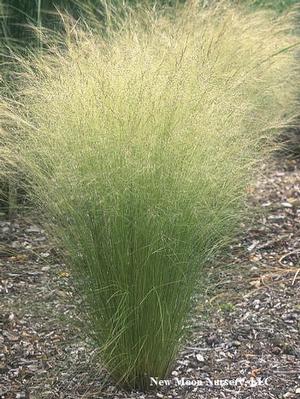Printed at http://www.newmoonnursery.com/index.cfm/
Nassella tenuissima
Mexican Feather Grass
Native to SW United States and Northern Mexico
FIRST IMPRESSIONS: Nasella tenuissima is a swaying fine textured clump forming grass. The crisp green blades are arching and extremely narrow. Foliage can be semi-evergreen or deciduous depending on the climate. In summer narrow panicles of creamy long awned spikelets appear. By late summer or autumn plants are crowned with buff colored seedheads. This grass prospers in sunny sites with a wide variety of soils.
HABITAT & HARDINESS: Nasella tenuissima is native to rocky open slopes, dry woods with shallow rocky soils, grasslands and montane forest clearings.
Plants occur in New Mexico, west Texas and in Mexico, Chile and Argentina.
Plants are hardy from USDA Zones 6-10.
PLANT DESCRIPTION: Nasella tenuissima forms upright tufted mounds of fine textured hair-like foliage.
Foliage is less than 1/8” wide and up to 12” long. Leaves are glossy and usually rolled into a threadlike cylinder. The pale silvery green blades are very mobile with a tendency to wave in the slightest breeze.
Narrow upright 4-12” flower panicles appear in summer. Panicles are composed of 60-480 pale yellow or silvery whiskered spikelets.
The spikelets mature into feathery tan or gold seedheads.
Blooming plants are about 1-2’ tall and 1’ wide. This species performs as a perennial through zone 7 but is usually a reseeding annual in areas with colder winters.
CULTURAL & MAINTENANCE NEEDS: Nasella tenuissima prospers in sunny or lightly shaded sites with fertile well drained soil.
Plants adapt to a wide range of conditions – moderate salinity, drought, slightly acid or alkaline pH and heavy clay or sandy soil. This species thrives in coastal sites with excessive wind but is intolerant of sites with poorly drained soils.
This is a cool season grass that may become dormant during extremely hot summer weather.
Plants should be groomed or cut to the ground in early spring to remove tattered foliage and make way for new foliage.
This grass is pest resistant and fairly unpalatable to deer and other herbivores.
Plants often reseed in the landscape. To prevent unwanted seedlings, deadhead to remove seedheads before they ripen.
LANDSCAPE USES: Nasella tenuissima is a handsome Groundcover that brightens Containers or sunny Meadows. The species is sometimes used as an Accent, Edging or Mass Planting. Plants provide Cut Flowers and Erosion Control to Deer Resistant Plantings, Low Maintenance Gardens, Perennial Borders or Rock Gardens.
COMPANION & UNDERSTUDY PLANTS: Try pairing Nasella tenuissima with Agastache foeniculum, Amsonia hubrichtii, Deschampsia caespitosa, Echinacea purpurea, Liatris spicata ‘Kobold’ or Penstemon calycosus.
Sporobolus heterolepis is a fine textured grass with similar cultural needs that can be substituted if needed.
TRIVIA: In 2010 Nasella tenuissima was recognized as a Best Selection by the University of Wisconsin. In 2007 the grass was designated as Arboretum Approved by the Dallas Arboretum.
Stipa tenuissima is also known as Nassella tenuissima. Other common names for the species include: Silky Thread Grass, Mexican Wiregrass, Finestem needlegrass, Ponytail grass and Texas tussock.
This species is a favorite of renowned garden designer Piet Oudolf. It is included in his designs in New York City’s Highline and Chicago’s Lurie Garden.
In Argentina, Nasella tenuissima is considered to be an unpalatable forage grass. After consumption, the grass forms an indigestible ball in the stomach of livestock that may cause cattle to lose weight.
Height:
12-24 inSpread:
12 inSpacing:
12 inUSDA Hardiness Zone:
6-10Bloom Color:
WhiteNassella tenuissima Characteristics
Attracts Wildlife
- Pollinators
Attributes
- Interesting Foliage
- East-Coast Native
- Drought Tolerant
- Dried Flower
- Cut Flower
- Rock Garden
- Container
- Naturalizing
Exposure
- Full Sun to Partial Shade
Deer Resistant
- Deer Resistant
Flowering Months
- August
- July
Foliage Color
- Green
Grass Season
- Cool Season Grass
Growth Rate
- Medium
Salt Tolerance
- Medium
Season of Interest (Foliage)
- Fall
- Summer
- Spring
- Winter
Soil Moisture Preference
- Moist to Dry

